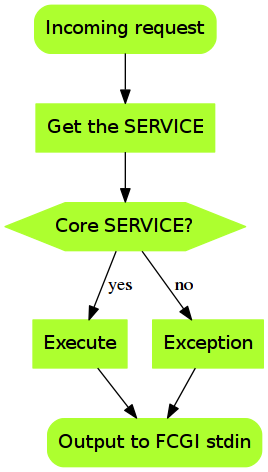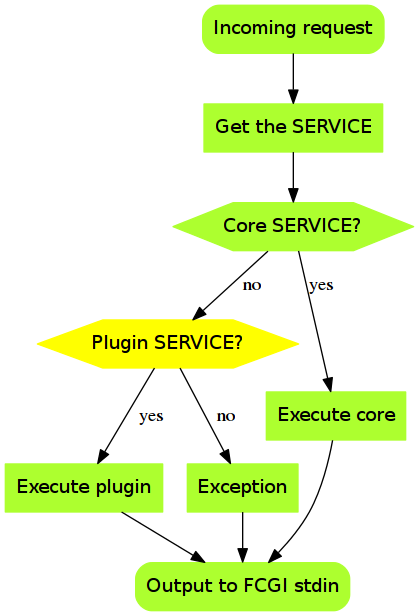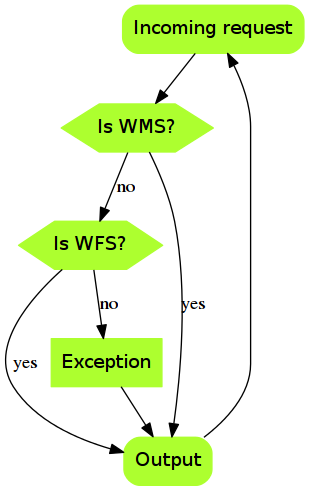RFC for QGIS Server Python Plugins
Alessandro Pasotti (a.pasotti@itopen.it)
Goals
- Provide hooks to modify existing services by manipulating input and output
- Provide hooks to extend QGIS server by adding new services
- Lower the barrier to develop new services by using Python
- Maintain deployment and configuration extensions as easy as possibile (GUI-based one-click install & deployment)
- Prototyping of new services
Not goals
- Replace the existing professional solutions available for heavy duty webservices
Possible applications
- web clients configuration
- authentication/authorization
- new services (WPS etc.)
- new output formats
Implementations
Two possibilities:
- 404 handler - Simplest, hack-ish but unobtrusive and FAST! and KISS and DRY and [place your favourite pattern here!]
- Observer - Full-featured but with a minimal overhead and will require an heavy refactoring of the existing request handling code
Standard flow

404 handler

404 pros & cons
Pros
- unobtrusive: just three lines of codes added to main loop
- CGI-style plugins
- Minimal overhead when FCGI starts
- 0 (zero) overhead on core SERVICES: FAST!
- re-use current Python Plugins loading mechanism
- proof-of-concept simplest implementation done
Cons
- no way to manipulate request and response generated from core services
Observer overview
Observer pattern: plugins will register themselves and listen to signals. Plugins will receive the request/response objects and they will be able to manipulate them:
- at FCGI startup
- after the request object is created
- before the response is sent to the client
- if there is no match with core services (404 handler)
Observer flowchart

Observer pros & cons
Pros
- Provides all the possibilities to manipulate the request and response and extend QGIS Server
Cons
- requires heavy refactoring of request handler --> request/repsponse handler
- could introduce some (probably tiny) overhead even if there aren't any plugins installed/enabled
404 PoC Implementation Details
FCGI application starts and maintain an hash of services exposed by the plugins
When FCGI loop ends without a match for the core services (WMS, WFS, WCS) the 404 handler matches SERVICE with the service metatag exposed by the plugin.
- If there is a match we do more checks:
- the REQUEST parameter must match the CSV list of plugin's exposed methods, as declared in the methods metadata
- the plugin loads without errors
- the plugin has a method named as the REQUEST
Example query string:
http://localhost/cgi-bin/qgis_mapserv.fcgi?SERVICE=HELLO&REQUEST=SayHello
404 PoC metadata
Python methods (static!) are invoked and their output is captured and passed on to FCGI
Plugins exposed SERVICE and REQUEST methods are listed in Plugin's metadata:
Example metadata:
service=HELLO methods=GetCapabilities,GetOutput,RemoteConsole,SayHello
404 PoC methods
When all checks are done the plugin runs by calling the method in the REQUEST, the method receives:
- the project path and
- the query string as parameters.
The plugin (static) method has access to global python environment and can run arbitrary python commands, it can optionally return a content type string (the server defaults to text/plain).
The plugin CGI-style output is captured diverting stdout and stderr to a custom buffer which becomes the server response.
404 PoC example method
@staticmethod
def SayHello(project_path, parameters):
"""Just say something"""
print "HelloServer"
return 'text/plain'
Example response:
200 OK Connection: close Date: Thu, 04 Sep 2014 09:56:36 GMT Server: Apache/2.4.7 (Ubuntu) Vary: Accept-Encoding Content-Length: 12 Content-Type: text/plain Client-Date: Thu, 04 Sep 2014 09:56:36 GMT Client-Peer: 127.0.0.1:80 Client-Response-Num: 1 HelloServer
Observer refactoring

Observer current loop
The current main loop:
- Get the request
create GET/POST/SOAP request handler
- if SERVICE is WMS/WFS/WCS
- create WMS/WFS/WCS server passing in request handler take()
- call server's executeRequest()
- call request handler output method
else Exception
Observer refactoring
The new main loop:
- Get the request
create GET/POST/SOAP request handler
pass request to iFace
call plugins (emit request signal)
- if there is not a response
- if SERVICE is WMS/WFS/WCS
- create WMS/WFS/WCS server
- call server's executeRequest()
- store the byte stream output and content type in the request handler
call plugins (emit 404 signal)
call plugins (emit response signal)
- if there is not a response
store Exception in the request handler
request handler output the response
Server iFace
Not sure about what should be exposed:
- request/response handler
- capabilities cache
- renderer
- logger ?
To GUI or not to GUI?
Should we use the same system for desktop and server plugins?
What is the (mostly) unique selling point of QGIS Server ?
GUI-based configuration of the map and the services!
A Server plugin can have (not must) a desktop interface aimed to configure itself
One-click install and deployment
Example(s)
An example plugin is available:
https://github.com/elpaso/qgis-helloserver
A running implementation of the sever plugins basic functionalities is available here:
https://github.com/elpaso/QGIS/tree/serverplugins
Local test:
http://qwc/cgi-bin/qgis_mapserv.cgi?SERVICE=HELLO&request=GetCapabilities http://qwc/cgi-bin/qgis_mapserv.cgi?SERVICE=HELLO&request=SayHello http://qwc/cgi-bin/qgis_mapserv.cgi?SERVICE=HELLO&request=RemoteConsole http://qwc/cgi-bin/qgis_mapserv.cgi?SERVICE=WPS&request=GetCapabilities
Restrictions
If the plugin has a Desktop interface it cannot usually access to user's QSettings, this means that plugins options have to be stored somewhere else in order to be accessible by the server side.